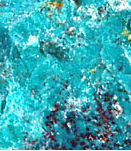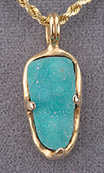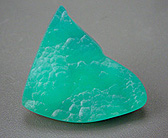
The common mineral quartz, occurs both in the familiar single crystal varieties of amethyst, citrine, rose quartz, etc, and also in a number of aggregate forms. These aggregates, such as agate, jasper, and chalcedony, are made up of submicroscopic quartz crystals intermeshed together. When the quartz aggregates are translucent, and of a single color, they are known as chalcedonies. Examples of well known types of chalcedony are brown to orange carnelian, and apple green chrysoprase.
Less common, and more valuable, is a type of chalcedony with vivid greenish blue color, frequently referred to as "gem silica" in the trade. More correctly it would be called chrysocolla chalcedony. Structurally it is composed of near colorless chalcedony that has been stained, on a microscopic level, by infiltration of solutions carrying the same copper salts which give color to the mineral chrysocolla.
If it is evenly stained throughout, it has an intense, uniform, slightly to moderately greenish blue color. Chrysocolla itself, though beautifully colored, is far too soft and fragile (H = 2 - 4) to be useable for jewelry purposes. Additionally, pieces of pure chrysocolla generally have a chalky, crumbly texture, or occur as thin powdery crusts on the surface of a rock.

The so-called, "gem silica", however, since it is actually a type of chalcedony with quartz's hardness of 7, and excellent toughness, is quite suitable for jewelry use. Sources include, Arizona, New Mexico, Mexico, Taiwan and the Philippines. Rarely, gem silica occurs in botryoidal (with a bubble-textured surface) or drusy (with a sugar-like crystal coating) form.




The most valuable specimens of this kind of material are those that are highly translucent, evenly colored, free from inclusions, and strongly saturated in color. People who may not realize the rarity of such stones, are, sometimes, taken aback by the relatively high price for what is afterall, a form of quartz, and a cabochon stone to boot. Highly translucent cabochons of the most vivid color may retail for as much as $100/ct.
Increased demand and familiarity with this gem has been occasioned by top gem carvers and goldsmiths recently making this stone a "gem of choice". There has also been intense interest by Oriental collectors which has driven prices up as well. Those specimens which tend to greenish hues and which are opaque, included, or uneven in color are much less costly.